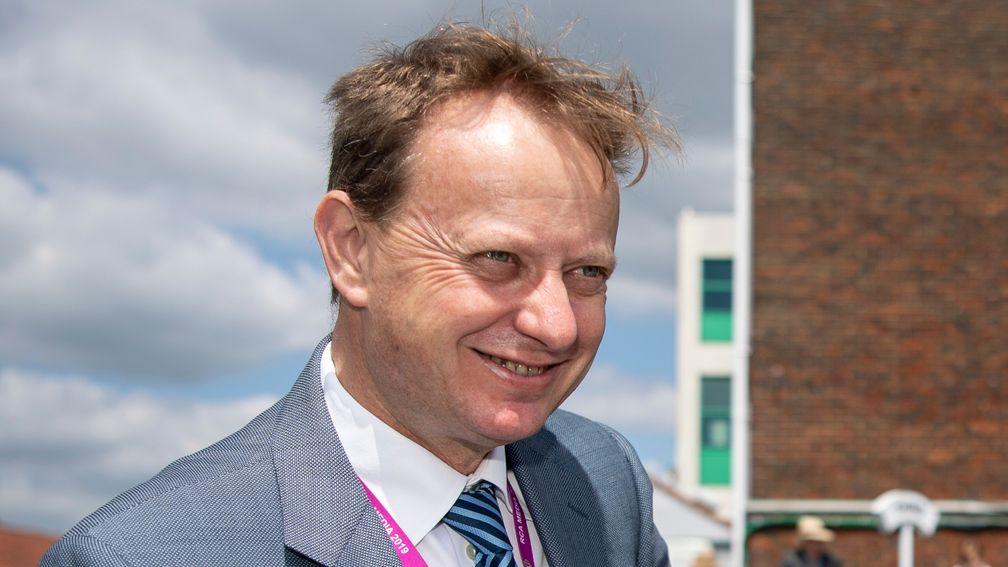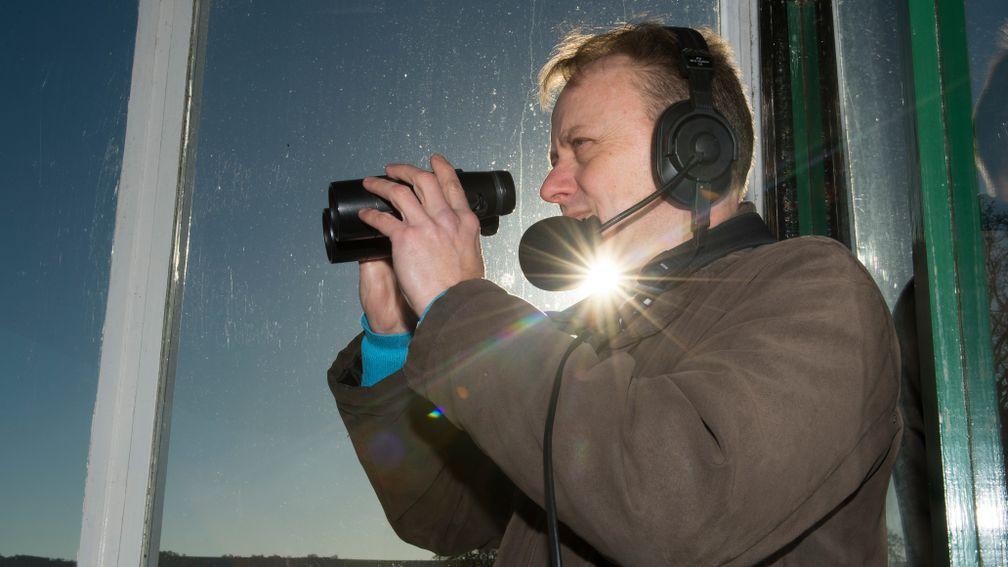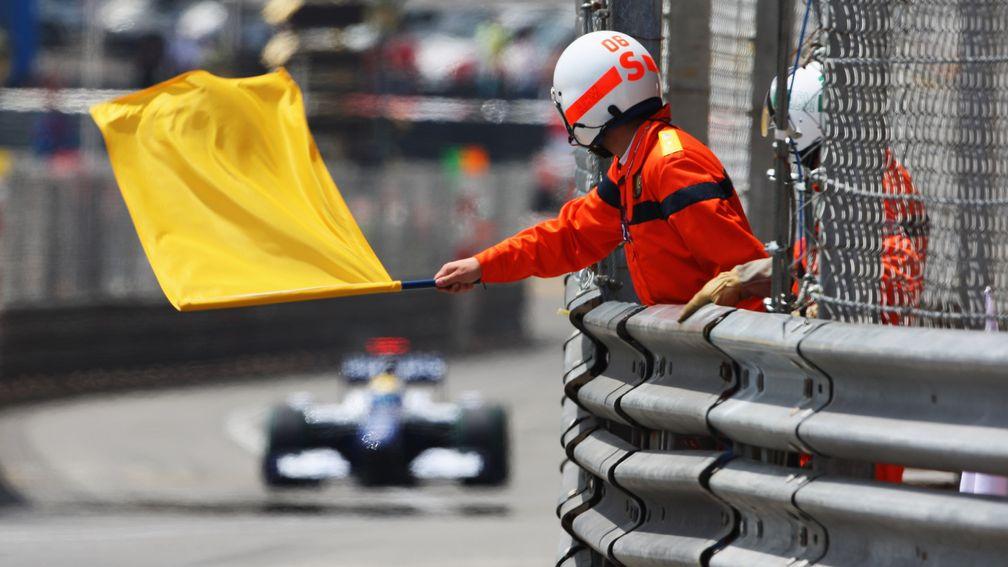Commentator Simon Holt backs call for red stop-race flags after Sandown fiasco

Leading commentator Simon Holt has backed trainer Olly Murphy's call for a change to the colour of racing's stop-race flag from yellow to red to help prevent a repeat of the calamitous conclusion to Saturday's London National.
Seven jockeys were given ten-day bans, which they are appealing, after continuing to ride in Sandown's final race despite a yellow flag, meaning jockeys should stop riding, being shown on the turn for home.
Staff on the course were attending to Houblon Des Obeaux, who suffered a fatal heart attack on the first circuit.
There has been criticism that the stop-race flag was not actively waved and that the way it was pointed confused jockeys into bypassing the fence.
Holt, who did the Racing TV and racecourse commentary on Saturday, said: "I'd have to agree with Olly Murphy's comments in the [Racing Post] piece on Monday morning that he's not sure why the flag is yellow, when in everybody's language the colour for stop is red.
Members can read thoughts from Olly Murphy and Charlie Swan on the void race at Sandown
"Yellow, like an amber traffic light, means be wary, so I just don't understand why it was yellow in the first place. It should be a bright red flag – that would certainly help.
"That would be one change they [the BHA] might make and I would be surprised if they didn't. These things happen so rarely that invariably they catch everyone by surprise."
Holt did not spot that the race had been voided during his commentary. He said: "I was a bit disappointed in myself as I know full well a yellow flag means stop the race.
"I suppose in the heat of the moment it looked to me as though they were being waved around the fence and that's how I interpreted it. If I had it [the call] again I would have said 'yellow flag, stop the race'."

"It would have been far better if the flag was waved at the bottom of the straight in the long flat area, although it's easy to say that in hindsight. I feel sympathy for the groundstaff, who had to bravely go out on the course with horses thundering towards them."
Richard Hoiles, who was commentating for ITV, said other sports had procedures for stopping races that were easier to understand.
He said: "For the lay viewer, racing's flags are a bit bizarre. In Formula One the yellow flag means slow down, hazard, no overtaking, while the chequered flag means end, and a red flag is for stop."
Hoiles felt the incident, before the third-last fence, occurred at the worst possible place. He said: "Very few courses in the country have an 'S' formation. Unless it's right off the bend, the jockeys will get a much better line of sight than they had at Sandown – on a flatter track you'd see the screen behind the flag.
"The man waving the flag was in as good a place as he could have been but they [the jockeys] couldn't see him as it was on the crown of the bend.
"It happened in the most unfortunate place. It was horrible in the circumstances and I have sympathy for those trying to keep everyone safe."
The BHA has pointed out that one in 12 males in the UK are colour blind, with red/green colour blindness the most common form.

Follow the flags: how it works in F1
Like racing, Formula One uses a system of flags to indicate to drivers certain situations that are taking place on other parts of the course.
Given the speed at which participants race, the flags need to be clearly understandable and shown in a way that allows drivers to instantly see them and be able to react to avoid problems.
The three main flags in Formula One are: a yellow flag, a red flag and a black and white chequered flag, although there are several other types of flag that can be used for certain situations (albeit in reality many have been replaced by electronic indicators instead).
A yellow flag is an indication to be cautious and reduce your speed. If a single yellow flag is waved then that means there is danger ahead, such as an obstruction, and drivers should be prepared to slow down. A double yellow flag means there has been an accident and a driver should be prepared to potentially stop. In both instances of yellow flags, drivers must not overtake or risk being penalised. Racing is restarted by the flying of a green flag.
A red flag is the most severe sign and is an unequivocal signal to stop racing immediately. This is normally because there has been a serious accident somewhere on the track and continuing to race is dangerous, or because the weather has made it impossible to race.
The chequered flag is the most famous one in Formula One and the one that drivers wants to see. This means the race is over and the first driver to see the chequered flag is the winner.
Members can read the latest exclusive interviews, news analysis and comment available from 6pm daily on racingpost.com
Published on 9 December 2019inNews
Last updated 17:16, 9 December 2019
- The latest edition of the Racing Post is available to read online now - here's how you can access it
- How Smart View recorded a 76 per cent profit at the Cheltenham Festival
- Smart View is available on the Racing Post app - how to read the revolutionary new racecard
- Levy reform talks 'accelerating' as clock ticks down to April deadline for agreement
- Kieran Shoemark lands another plum Meydan ride for Gosden stable on Trawlerman in Saturday's Dubai Gold Cup
- The latest edition of the Racing Post is available to read online now - here's how you can access it
- How Smart View recorded a 76 per cent profit at the Cheltenham Festival
- Smart View is available on the Racing Post app - how to read the revolutionary new racecard
- Levy reform talks 'accelerating' as clock ticks down to April deadline for agreement
- Kieran Shoemark lands another plum Meydan ride for Gosden stable on Trawlerman in Saturday's Dubai Gold Cup